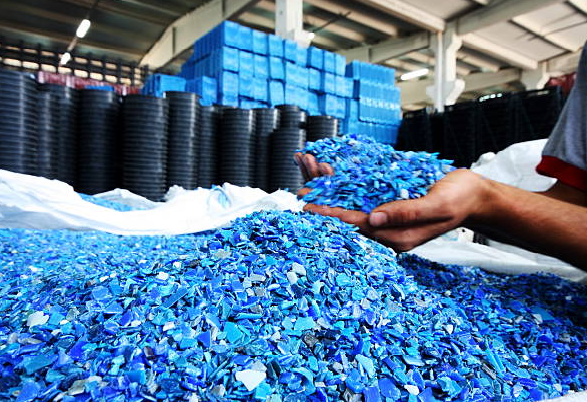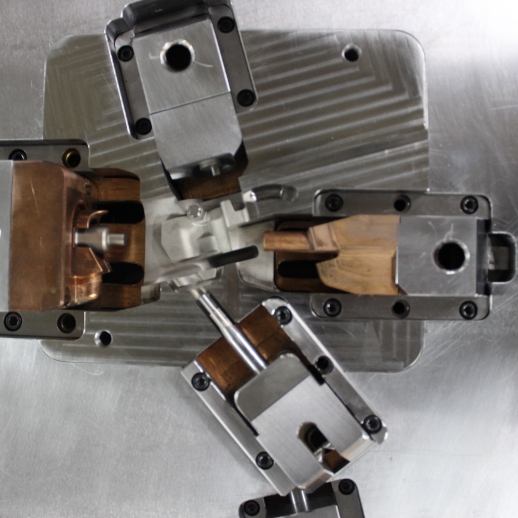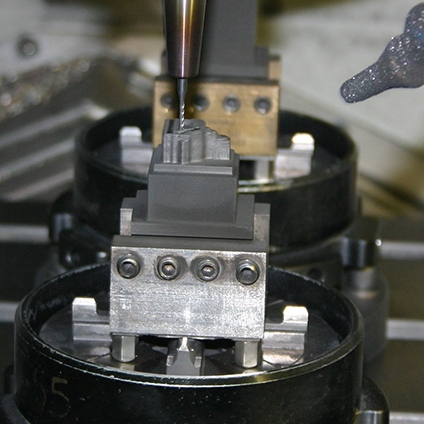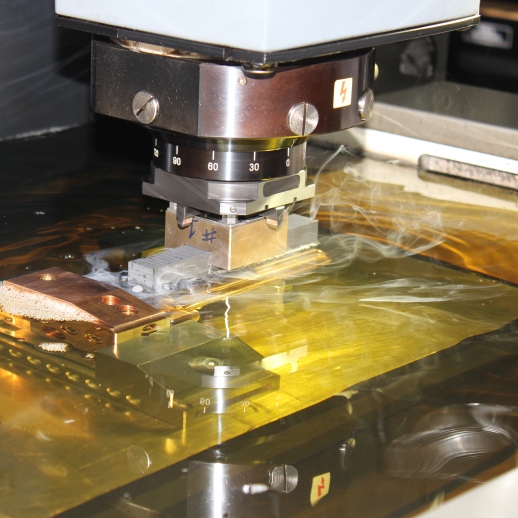Selecting the correct material for each application requires in-depth knowledge of injection molding resins, as well as a thorough understanding of the product’s application.
At Ayanna Plastics & Engineering, we offer our customers a variety of injection molding resins and injection molding materials, from commodity grades to engineering grades. We also make it our business to understand our customers’ needs to make the best recommendations regarding material choices.

As an engineering and plastic injection molding company, we do not limit the types of materials we process. There are more than 8,000 injection molding resins on the market today, and we partner with our resin suppliers to find the best solution for our customers. We bring you access to some of the most knowledgeable distributors in the industry.
The resins listed below are merely a sampling of the most common injection molding materials.
- ABS (Acrylanitrile Butadiene Styrene)
- ABS + PC (ABS + Polycarbonate)
- Acetal (POM)
- PA-Nylon 6 (Polyamide)
- PA-Nylon 6/6 (Polyamide)
- PA-Nylon 11 (Polyamide)
- PBT (Polybutylene Terepthalate)
- PC (Polycarbonate)
- PEI (Polyetherimid)
- PE (Polyethylene)
- LDPE (Low Density Polyethylene)
- HDPE (High Density Polyethylene)
- PET (Polyethylene Terepthalate)
- PP (Polypropylene)
- PPA (Polyphthalamide)
- PPS (Polyphenylene Sulfide)
- PS (Polystyrene)
- HIPS (High Impact Polystyrene)
- PSU (Polysulfone)
- PU (Polyurethane)
- SAN (Styrene Acrylonitrile)
- TPE (Thermoplastic Elastomer)
- TPU (Thermoplastic Polyurethane)
If you would like to research any of these materials in more detail, follow these links to industry sources:
ABS (Acrylanitrile Butadiene Styrene)
ABS plastics provide a balanced combination of mechanical toughness, wide temperature range, good dimensional stability, chemical resistance, electrical insulating properties, and ease of processing. ABS plastic is available in a wide range of grades including medium and high-impact, heat-resistant, plateable fire-retardant, and both low- and high-gloss varieties.
Applications
Computer housings, small appliances, automotive interior trim, medical components, and thin-walled parts
Advantages
- Good impact resistance with toughness and rigidity
- Metal coatings have excellent adhesion to ABS
- Ease of processing and appearance
- Wide range of additives available
Disadvantages
- Not weather resistant
- Low dielectric strength (not a good insulator)
- Low continuous service temperature (melts easily)
- Price varies greatly depending on grade
ABS + PC (ABS + Polycarbonate)
PC + ABS plastics offer the properties of both PC and ABS including the strength and heat resistance of PC and the flexibility of ABS with exceptional low temperature impact strength. The material can be modified by additives such as glass fiber, mineral fillers, and flame retardants.
Applications
Medical hardware, electrical housings, computers, monitors, business equipment housings and enclosures
Advantages
- Good impact resistance with toughness and rigidity even at cold temperatures
- Metal coatings have excellent adhesion to ABS
- Very good indoor UV light color stability
- Ease of processing and appearance
- Wide range of additives available
Disadvantages
- Not weather resistant
- Low dielectric strength (not a good insulator)
- Low continuous service temperature (melts easily)
Acetal (POM) (Polyoxymethylene)
Acetal polymers are high crystalline. POM is a high strength and stiff polymer with electrical properties, inherent lubricity, fatigue resistance, and chemical resistance. Acetals are brittle at low temperatures. Glass-filled and added-lubrication grades are available.
Applications
Gears, bearings, automotive, industrial, machines and appliances
Advantages
- High tensile strength with rigidity and toughness
- Good impact and solvent resistance
- Glossy molded surface
- Low static and dynamic coefficients of friction (slippery)
- Many grades have FDA and NSF approvals on food and water contact
Disadvantages
- Difficult to bond
- Poor resistance to acid and bases
- Not flame retardant
- Subject to UV degradation
Nylon 6-PA (Polyamide)
Nylons are semi-crystalline polymers with a good range of properties. Nylons are widely used because they have a good cost-to-performance ratio. Lower numbered nylons, 6, 6-6, 4-6, absorb moisture and change their properties as a result. Nylons have been compounded with reinforcements, fillers and additives to produce a very wide variety of properties. Nylon 6 has the lowest modulus of all nylon grades.
Applications
Zip fasteners, gears, gun frames, instrument strings, surgical sutures, bearing, electronic components
Advantages
- Temperature capability 600°-700° for short term
- Excellent chemical resistance
- High resistance to abrasion
- Tough and withstands repeated impact
Disadvantages
- Absorbs moisture (can affect the electrical and mechanical properties)
- Requires UV stability
- Attacked by strong acids/bases
- High notch sensitivity
Nylon 6-6-PA (Polyamide)
Nylons are semi-crystalline polymers with a good range of properties. Nylons are widely used because they have a good cost-to-performance ratio. Lower numbered nylons, 6, 6-6, 4-6, absorb moisture and change their properties as a result. Nylons have been compounded with reinforcements, fillers, and additives to produce a very wide variety of properties. Nylon 6-6 offers better properties than nylon 6 without being as costly as nylon 4-6. It has the best abrasion resistance of all nylons. Verton, long glass fiber filled materials, by LNP, are excellent metal replacement materials.
Applications
Automotive components, electronic connectors, gears, cable ties and power tool housings
Advantages
- Temperature capability 600°-700° for short term
- Excellent chemical resistance
- High resistance to abrasion
- Tough and withstands repeated impact
Disadvantages
- Absorbs moisture (can affect the electrical and mechanical properties)
- Requires UV stability
- Attacked by strong acids/bases
- High notch sensitivity
Nylon 11-PA (Polyamide)
Nylons are semi-crystalline polymers with a good range of properties. Nylons are widely used because they have a good cost-to-performance ratio. Lower numbered nylons, 6 ,6-6, 4-6, absorb moisture and change their properties as a result. Nylons have been compounded with reinforcements, fillers, and additives to produce a very wide variety of properties. Nylon 11 offers better impact strength and dimensional stability than lower numbered nylons. It is also more flexible.
Applications
Automotive components, electronic connectors, gears, cable ties and power tool housings
Advantages
- Temperature capability 600°-700° for short term
- Excellent chemical resistance
- High resistance to abrasion
- Tough and withstands repeated impact
Disadvantages
- Absorbs moisture (can affect the electrical and mechanical properties)
- Requires UV stability
- Attacked by strong acids/bases
- High notch sensitivity
PBT Polyester (Polybutylene Terepthalate)
PBT polyesters are semi-crystalline. They are versatile materials with a good range of properties. They have excellent electrical properties and are abrasion resistant. PBT has been extensively compounded giving a very wide range of properties. PBT performs much like Nylon but can handle higher temperatures and does not absorb moisture. PBT has excellent impact strength but is very notch sensitive. PBT is very anisotropic in shrinkage, so it is difficult to mold to extremely tight tolerances.
Applications
Industrial equipment applications, business equipment, automotive housings-under the hood, power tool housings
Advantages
- Good flow
- Tough
- Hydrollysis resistant
- High impact
- Easily processed
Disadvantages
- Low maximum-use temperature
- Lower stiffness than similar PET
- Lower strength than similar PET
- Attacked by strong bases
PC (Polycarbonate)
Polycarbonate is an amorphous material with excellent impact strength, clarity, and optical properties. It is very widely used, and a wide variety of compounds are available. Polycarbonate has excellent mechanical properties and can be molded to tight tolerances. It is not very resistant to solvents and petrochemicals, and its weather resistance is only adequate.
Applications
Automotive headlights, business machines, consumer products, telecommunications, medical products, and mechanical goods
Advantages
- High impact resistance
- Clarity
- Good flammability performance
- Dimensional stability
- Chemical resistance (PC blends)
Disadvantages
- Only fair solvent resistance
- Subject to stress cracking
- Degrades if not processed correctly
- High processing temperature
- Yellowing after long-term exposure to UV light
PEI (Polyetherimid)
PEI is an amorphous, high temperature material with relatively low cost compared to other high temperature materials. It has excellent elongation and impact strength and can be molded to tight tolerances. Its chemical resistance is not as good as crystalline materials but is excellent for an amorphous material. PEI behaves similar to polycarbonate but can perform at higher temperatures.
Applications
Commercial aircraft interiors, healthcare products, cooking utensils, fiber optics, electrical and electronic applications
Advantages
- High heat resistance
- Exceptional strength and impact modulus
- High dielectric strength
- Broad chemical resistance
- Biocompatible
- Excellent machinability and finishing characteristics
- Very easy to process on conventional molding equipment
- Flame resistance with low smoke evolution
Disadvantages
- Translucent and opaque-clear is not available
- High cost
- Notch sensitive
- High processing temps required
PE (Polyethylene)
Polyethylene is a widely used, inexpensive, thermoplastic. It has good inherent lubricity and is easy to process. Polyethylene has good to excellent chemical resistance. It is also soft and cannot be used in temperatures much above 150. As a family, they are light in weight and possess toughness, chemical resistance, impermeability as well as excellent electrical insulating properties.
Applications
Consumer products, houseware items, electronic wire/cable insulators and medical products
Advantages
- Low cost
- Impact resistance from -40° to 194° F
- Moisture resistance
- Food grades available
Disadvantages
- Poor weather resistance
- High thermal expansion
- Subject to stress cracking
- Difficult to bond
- Flammable
- Poor temperature capability
LDPE (Low Density Polyethylene)
Polyethylene is a widely used, inexpensive, thermoplastic. It has good inherent lubricity and is easy to process. Polyethylene has good to excellent chemical resistance. It is also soft and cannot be used in temperatures much above 150. As a family, they are light in weight and possess toughness, chemical resistance, impermeability as well as excellent electrical insulating properties. Low density polyethylene is the softest and most flexible version of this material. It has high elongation giving it excellent impact strength. This is offset by its permanent deformation upon impact.
Applications
Consumer products, houseware items, electronic wire/cable insulators and medical products
Advantages
- Low cost
- Impact resistance from -40° to 194° F
- Moisture resistance
- Food grades available
Disadvantages
- Poor weather resistance
- High thermal expansion
- Subject to stress cracking
- Difficult to bond
- Flammable
- Poor temperature capability
HDPE (High Density Polyethylene)
Polyethylene is a widely used, inexpensive, thermoplastic. It has good inherent lubricity and is easy to process. Polyethylene has good to excellent chemical resistance. It is also soft and cannot be used in temperatures much above 150. As a family, they are light in weight and possess toughness, chemical resistance, impermeability as well as excellent electrical insulating properties. High density polyethylene is the hardest and stiffest version of this material. It does not have the impact strength of low density but is more resilient.
Applications
Consumer products, houseware items, electronic wire/cable insulators and medical products
Advantages
- Low cost
- Impact resistance from -40° to 194° F
- Moisture resistance
- Food grades available
Disadvantages
- Poor weather resistance
- High thermal expansion
- Subject to stress cracking
- Difficult to bond
PET Polyester (Polyethylene Terepthalate)
PET polyesters are semi-crystalline. They are versatile materials with a good range of properties. They have excellent electrical properties and are abrasion resistant. PET has not been as extensively compounded as PBT because it is more difficult to process. PET has a higher modulus than PBT. Like PBT, PET is very anisotropic in shrink; therefore, it is difficult to mold to extremely close tolerances.
Applications
Reusable bottles, pacifiers, sippy cups, medical devices, housewares
Advantages
- High temperature resistance
- Some grades FDA approved
- Excellent toughness
- Excellent clarity
- Easy processing
Disadvantages
- Highly susceptible to degradation when heated above 150°C in the presence of moisture
- Cannot be exposed to elevated temperatures
- Must be thoroughly dried prior to processing
PP (Polypropylene)
Polypropylene is a widely used, semi-crystalline material. It has been extensively compounded to provide a wide range of properties at a wide range of costs. In general, polypropylene is a low temperature material with excellent chemical resistance. It has no known solvent at 73 F. Polypropylene is difficult to mold to extremely close tolerances.
Applications
Packaging, industrial components for fluid processing, household goods, automotive and electrical hardware
Advantages
- Excellent moisture resistance
- Food grades available
- Mold-in hinge possible
- Good impact strength
Disadvantages
- Degraded by UV
- Flammable (retardant grades available)
- Attacked by chlorinated solvents
PPA (Polyphthalamide)
PPA is a relatively new, semi-crystalline material, with an excellent cost-to-performance ratio. PPA bridges the performance gap between nylons/polyesters, and higher priced, high temperature materials such as PEI and PEEK. PPA has excellent impact strength and is not notch sensitive. PPA does absorb moisture, and its properties change as a result. This change is not nearly as great as 6-6 nylon. Despite its relatively recent introduction, good design data is available for PPA.
Applications
Automotive applications, housing for high temperature electrical connectors, multiple other uses as a replacement to metals
Advantages
- Heat resistance
- Chemical resistance
- Can resist infrared soldering environments
- Relatively low moisture absorption
- Strength or physical properties
Disadvantages
- Not inherently flame retardant
- Requires good drying equipment
- High processing temperatures
PPS (Polyphenylene Sulfide)
PPS is a high temperature semi-crystalline material. It has good mechanical properties and excellent chemical resistance at elevated temperatures. PPS has been compounded extensively and many different types of properties are available. PTFE filled PPS is one of the best bearing materials available. Unfilled grades of PPS have poor properties, so components are usually made from glass filled or glass/mineral filled grades. PPS is very sensitive to molding conditions and must be processed properly to achieve its maximum potential.
Applications
Hydraulic components, bearings, cams, valves, and electronic parts
Advantages
- Capable of extended usage at 450° F
- Good radiation resistance
- Good solvent and chemical resistance
- Excellent dimensional stability
- Flame retardant
- Low water absorption
Disadvantages
- Difficult to process (high melt temps)
- High cost
- Fillers required to obtain good impact strength
- Attacked by chlorinated hydrocarbons
PS (Polystyrene Crystal)
Crystal polystyrene is the cheapest thermoplastic available. It has properties to match its price. It is transparent and has good optical properties. It has very low impact strength.
Applications
Household goods, containers, furniture, housings, and packaging
Advantages
- Optical clarity
- High gloss
- FDA grades available
- Low cost
- Good dimensional stability
Disadvantages
- Flammable, but flame-retardant grades available
- Poor solvent resistance
- Homopolymers are brittle
HIPS (High Impact Polystyrene)
High Impact Polystyrene is what its name implies. A few cents more than crystal styrene, to pay for the rubber modifier. HIPS is opaque and very widely used. It has a lower modulus, better elongation, and is a lot less brittle than crystal styrene.
Applications
Household goods, containers, furniture, housings, and packaging
Advantages
- Optical clarity
- High gloss
- FDA grades available
- Low cost
- Good dimensional stability
- Good rigidity
Disadvantages
- Flammable, but flame-retardant grades available
- Poor solvent resistance
- Homopolymers are brittle
- Subject to stress and environmental cracking
PSU (Polysulfone)
Polysulfone is a high temperature amorphous material with relatively low cost. It is transparent and can be used at temperatures of up to 300 F. Polysulfone has been compounded, with glass- and mineral-filled grades available.
Applications
Appliance parts, electronic parts, automotive parts, medical components, business equipment, aerospace, and insulators
Advantages
- Good thermal stability
- Transparent
- Tough and rigid
- Chemical resistance
Disadvantages
- Attacked by many solvents
- Poor weatherability
- Subject to stress cracks
- High processing temperature
PU (Polyurethane)
Polyurethane is a resilient, extremely tough abrasion and tear resistant elastomeric material that is available in ether and ester-based formulations. These diverse formulations cover an extremely wide range of stiffness, hardness, and densities. These materials offer good chemical resistance and are transparent in unfilled grades.
Applications
Appliance parts, electronic parts, automotive parts, medical components, business equipment, aerospace, and insulators
Advantages
- High tensile strength
- Chemical and heat resistant
- Low temperature flexibility
- Abrasion resistant
Disadvantages
- Can be adversely affected by direct sunlight
- Attacked by organic solvents
SAN (Styrene Acrylonitrile)
SAN is ABS without the Butadiene. It does not have the Impact Strength of ABS but can be crystal clear. Styrene Acrylonitrile has better general chemical resistance than polystyrene and is cheaper than acrylic. It has a good combination of rigidity, strength, toughness, and transparency.
Applications
Battery cases, dials, knobs, switches, lenses, trays, containers, covers, dental & medical light diffusers
Advantages
- Heat resistant
- High clarity
- High flow and rigidity
- Dimensionally stable
Disadvantages
- Low impact strength
- High processing temps
- Flammable – smoke generation
TPE (Thermoplastic Elastomer)
Thermoplastic elastomers (TPE) are a combination of polymers (usually a plastic and a rubber) which consist of both thermoplastic and elastomeric properties, resulting in a product that is extremely easy to use in manufacturing a variety of products. TPEs require little or no compounding and no need to add reinforcing agents, stabilizers, or cure systems.
Applications
Automotive fluid delivery systems, household appliances, sporting goods, electrical and medical components
Advantages
- Low compression and tension set
- Easily processed
- Fatigue resistance
- Good tear strength
Disadvantages
- Flammable but flame-retardant grades available
- Extensive heat aging causes severe change in mechanical properties
- High cost
TPU (Thermoplastic Polyurethane Elastomer)
Thermoplastic polyurethane elastomers exhibit excellent abrasion and wear resistance and high tensile and tear strengths. TPUs are tough, durable, easy to clean and well-suited to applications that demand the elasticity of rubber combined with high stability. In addition, the inherent translucency of these products makes it easy to color and that is an added benefit in many applications.
Applications
Automotive and aerospace applications, medical and optical purposes, electrical wire and cable coverings
Advantages
- Chemical resistant
- Low temperature flexibility
- Abrasion and wear resistant
Disadvantages
- Shorter shelf life
- Lower stiffness than similar PET
- Drying required pre-processing
- Narrow hardness range



